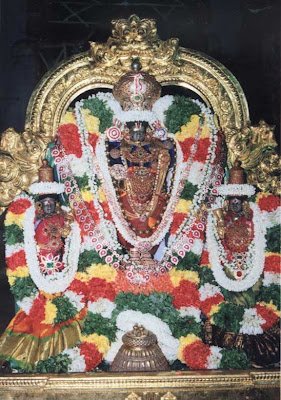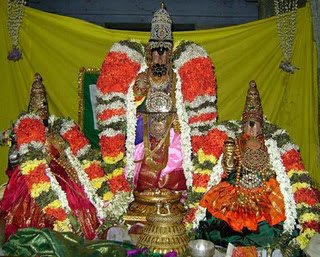srimathE rAmAnujAya nama:
srimadh varavaramunayE nama:
sri vAnAchala mahAmunayE nama:
In the previous article (https://granthams.koyil.org/2012/10/archavathara-anubhavam-kulasekara/) we observed kulasEkara AzhwAr’s archAvathAra anubhavam.
Let us now see periyAzhwAr’s archAvathAra anubhavam.

In upadhEsa rathina mAlai, 18th pAsuram, mAmunigaL glorifies the unique quality of periyAzhwAr in comparison to other AzhwArs.
manGgaLAchAchanaththil maRRuLLa AzhwArgaL thanGgaL (மங்களாசாசனத்தில் மற்றுள்ள ஆழ்வார்கள் தங்கள்)
ArvaththaLavu thAnanRi (ஆர்வத்தளவு தானன்றி)
ponGgum parivAlE villipuththur pattarpirAn peRRAn (பொங்கும் பரிவாலே வில்லிபுத்துர் பட்டர்பிரான் பெற்றான்)
periyAzhwAr ennum peyar (பெரியாழ்வார் என்னும் பெயர்)
Simple translation:
Because of his unlimited love towards doing mangaLAsAsanam to emperumAn is greater than the rest of the AzhwArs, pattarpirAn who was born in srivilliputhUr became to be famously known as periyAzhwAr.
It is also said that, because he is father-in-law of periya perumAL, he became to be known as periyAzhwAr.
In srivachana bhUshaNa dhivya sAsthram this quality of periyAzhwAr is nicely explained by piLLai lOkAchAryar in sUthrams 250 to 256. The greatness of mangaLAsAsanam is fully explained in sUthrams 244 to 258.
mangaLAsAsanam means desiring/praying for the well being of some one. AzhwArs were always looking out for emperumAn’s well being. But piLLai lOkAchAryar shows that periyAzhwAr’s attachment towards emperumAn is far greater than others. Let us see some of the sUthrams briefly to understand the glories of periyAzhwAr.
- sUthram 250 – AzhwArgaL ellAraiyum pOlallar periyAzhwAr (ஆழ்வார்கள் எல்லாரையும் போலல்லர் பெரியாழ்வார்) – periyAzhwAr is not like all the other AzhwArs.
- sUthram 251 – avargaLukku athu kAthAchiktham; ivarkkithu Nithyam (அவர்களுக்கு அது காதாசிக்தம்; இவர்க்கிது நித்யம்) – For the other AzhwArs, mangaLAsAsanam is once in a while, for periyAzhwAr it is always. mAmunigaL identifies that the other AzhwArs at times engage in enjoying bhagavath guNams and wants to enjoy it more and more. But periyAzhwAr is always looking out for the well-being of emperumAn and is never concerned about his own personal anubhavam.
- sUthram 252 – avargaLudaiya AzhanGkAl thAnE ivarkku mEdAyirukkum (அவர்களுடைய ஆழங்கால் தானே இவர்க்கு மேடாயிருக்கும்) – The beauty of emperumAn makes the other AzhwArs immerse themselves in that anubhavam. But the same thing makes periyAzhwAr worry about what could happen to such beautiful person and makes him do mangaLAsAsanam continuously.
- Further piLLai lOkAchAryar explains that periyAzhwAr’s qualities include worrying for everything in relation to emperumAn, inviting the unfavourable persons to become favourable, worrying for something which happened long ago, identifying that mangaLAsAsanam is the ultimate goal, etc.
- One of the main qualities of periyAzhwAr and emperumAnAr is that their aim is to bring jIvAthmAs to emperumAn to free him of his loneliness unlike other AzhwArs who are looking out for themselves to share their bhagavath anubhavam with others to free themselves from their loneliness.
- His purpose of existence is to do mangaLAsAsanam for emperumAn while other AzhwArs sustain by thinking about emperumAn’s name, form, qualities, etc and kainkaryam to him.
Finally piLLai lOkAchAryar says if we think about emperumAn coming down to this samsAram out of great love for the suffering jIvAthmAs, we should engage constantly in mangaLAsAsanam to archAvathAra emperumAns without any food and sleep just like periyAzhwAr did.
With this understanding, let us enjoy a few archAvathAra emperumAns glorified by periyAzhwAr.
thirukkOttiyUr sowmya nArAyaNan
ANdAL glorifies her father periyAzhwAr in her nAchiyAr thirumozhi as “bhOgaththil vazhuvAtha pudhuvaiyarkOn” (போகத்தில் வழுவாத புதுவையர்கோன்) – one who is constantly enjoying kaNNan emperumAn (and other vibhavAvathAra emperumAns) and performing mangaLAsAsanam to him. We can see this right in the beginning of his periyAzhwAr thirumozhi. After performing his mangaLAsAsanam in thiruppallAndu, he immediately starts thinking about kaNNan emperumAn and seeing the same emperumAn in thirukkOttiyUr as sowmya nArAyaNa perumAL.

vanNnNamAdanGgaL chUzh thirukkOttiyur (வண்ணமாடங்கள் சூழ் திருக்கோட்டியுர்)
kanNnNan kEchavan Nambi piRaNthinil (கண்ணன் கேசவன் நம்பி பிறந்தினில்)
enNnNey chunNnNam ethirethir thUvida (எண்ணெய் சுண்ணம் எதிரெதிர் தூவிட)
kanNnNan muRRam kalaNthaLaRAyiRRE (கண்ணன் முற்றம் கலந்தளறாயிற்றே)
periyAzhwAr is glorifying the birth of kaNNan emperumAn and the events that followed in AyarpAdi after his birth. All the gOpas and gOpis are ecstatic on hearing emperumAn’s birth and they celebrate by throwing a mixture of oil and colours on each other which makes the whole place muddy, But the speciality in this pAsuram is that AzhwAr is enjoying all of these in thirukkOttiyUr emperumAn.
Not only AzhwAr has great attachment to thirukkOttiyUr emperumAn, he is also a great admirer of the srivaishNavas of this dhivya dhEsam.
He was greatly inspired by selvanambi who was living in thirukkOttiyUr. He glorifies selvanambi as “abhimAna thungan selvan” in thiruppallANdu 11th pAsuram and “naLirntha seelan nayAsalan abhimAna thungan” in periyAzhwar thirumozhi 4.4.8 pAsuram. In the vyAkyAnam mAumunigal explains naLirntha seelan means “soothing souseelyam” i.e., his qualities are as lovable as the cool moon, nayAsalan means one who is very honest and abhimAna thungan means one who has suddha sAthvika ahankAram that he is surrendered to emperumAn and srivaishnavas (without any ego).
In nAva kAriyam padhigam (periyAzhwAr thirumozhi 4.4), AzhwAr enjoys the glories of the srivaishnavas of thirukkOttiyur. mAmunigaL in his avathArikai for this padhigam, explains that just like nammAzhwAr glorified archAvathAra emperumAns in cheyya thAmaraik kaNNan padhigam (thiruvAimozhi 3.6) and after that immediately glorified srivaishnavas who are attached to emperumAn in payilum chudaroLi padhigam (thiruvAimozhi 3.7), periyAzhwAr also first enjoys thirukkOttiyUr emperumAn and after that immediately starts glorifying the srivaishnavas of thirukkOttiyUr. It is explained that one of the main purposes of visiting dhivya dhEsams is to take shelter of the srivaishnavas who are living there.
In the 10th pAsuram in this padhigam, AzhwAr glorifies the srivaishNavas who are constantly engaged in glorifying the various names, forms of emperumAn. AzhwAr declares that he is so surrendered to such srivaishnavas that they can even sell him to anyone.
thiruvaranganAthan
veNNai vizhungi padhigam (periyAzhwAr thirumozhi 2.9) is one of the most wonderful set of pAsurams to enjoy navaneetha chouryam of kaNNan emperumAn (krishnan as butter thief). But, the beauty of this padhigam is that, after enjoying kaNNan emperumAn’s leelais in 10 pAsurams, in the 11th pAsuram, AzhwAr declares that he really glorified periya perumAL in those 10 pAsurams and it was periya perumAL who performed all those leelais in his vibhavAvathAram.

In periyAzhwAr thirumozhi 4.9.10, AzhwAr beautifully glorifies periya perumAL’s swAmithvam, etc.
cheruvALum puLLALan manNnNALan cheruch cheyyum NANthagamennumoruvALan (செருவாளும் புள்ளாளன் மண்ணாளன் செருச் செய்யும் நாந்தகமென்னுமொருவாளன்)
maRaiyALan OdAthapadaiyALan vizhukkaiyALan (மறையாளன் ஓடாதபடையாளன் விழுக்கையாளன்)
iravALan pagalALan ennaiyALan Ezhulagap perumpuravALan (இரவாளன் பகலாளன் என்னையாளன் ஏழுலகப் பெரும்புரவாளன்)
thiruvALan inithAgath thirukkanNgaL vaLarginRa thiruvaranGgamE (திருவாளன் இனிதாகத் திருக்கண்கள் வளர்கின்ற திருவரங்கமே)
Simple translation:
- cheruvALum puLLALan – Controller of garudAzhwAn who can himself handle any battle
- manNnNALan – Controller of leelA vibhUthi
- cheruch cheyyum NANthagamennumoruvALan – Controller of NANthagam which waits to kill the enemies
- maRaiyALan – Controller of vEdhas
- OdAthapadaiyALan – One who never runs away from battle field
- vizhukkaiyALan – One who has great audhAryam (generosity in helping others)
- iravALan pagalALan – Controller of day and night
- ennaiyALan – One who controls me
- Ezhulagap perumpuravALan – Controller of big land masses
- thiruvALan – Dear husband of periya pirAtti sri mahAlakshmi
- inithAgath thirukkanNgaL vaLarginRa thiruvaranGgamE – periya perumAL is lying down with great happiness (ugantharuLina nilam) because this is where all the ananya prayOjana bhakthas approach him.
In thuppudaiyArai padhigam (4.10), AzhwAr requests emperumAn to relieve him of his sAmsArika dhukkams so he can perform mangaLAsAsanam in nithya vibhUthi eternally for ever. mAmunigaL in the avathArikai enquires why AzhwArs are asking emperumAn for mOksham considering they are fully dependant on emperumAn as they were given divine, blemishless knowledge by emperumAn. He himself clarifies that even though AzhwArs are fully dependant on emperumAn, looking at the cruelty of samsAram and as emperumAn is sarva svathanthran because of which he has the full right to put them through the troubles of samsAram again, they ensure that emperumAn is clear about their intentions. So, mAmunigaL establishes that it is out their utmost unbearable situation in samsAram they ask for mOksham and there is nothing wrong with that.
Here he identifies one of the most important concepts of our sampradhAyam relating to anthima smrithi.
In the first pAsuram itself AzhwAr says “appOthaikku ippOthE solli vaiththEn” to periya perumAL. AzhwAr reminds emperumAn about his words to bhUmi pirAtti as varAha nAyanAr when he said “aham smarAmi” – that he will remember his bhakthas during their last moments even if they dont. Because during the final moments we may not be able to think about emperumAn, so emperumAn considers our surrender that was done long ago when our senses were proper and delivers us. This does not mean that we should not think about emperumAn in the last moments – if possible, we should always think about emperumAn. This is also in line with dhEva perumAL’s instruction of “anthima smrithi varjanam” to emperumAnAr through thirukkachi nambigaL.
thiruveLLarai pundarikAkshan
In srivachana bhUshaNa dhivya sAsthram sUthram 244, piLLai lOkAchAryar explains that:
manGgaLAchAsanam svarUpa viruththamanRO ennil jnYAna thachaiyil rakshyarakshaka bhAvam than kappilE kidakkum; prEma thachaiyil thattumaaRik kidakkum. (மங்களாசாஸனம் ஸ்வரூப விருத்தமன்றோ என்னில் ஜ்ஞான தசையில் ரக்ஷ்யரக்ஷக பாவம் தன் கப்பிலே கிடக்கும்; ப்ரேம தசையில் தட்டுமாறிக் கிடக்கும்.)
Simple translation:
If we consider praying for great personalities’ well being as not a proper attitude, when we look at it from a normal knowledgable situation the protected/protector relationship will stay normally, but from an extreme love/attachment situation, the proctected/protector will be reversed.
mAmunigaL explains in the vyAkyAnam that, one who understands thirumanthram properly, will think that emperumAn is sarvashakthan and he is the protector. But for the ones who are extremely attached to emperumAn’s beauty, tender nature, etc., they will think that they are the protector and emperumAn must be protected.
This principle is clearly demonstrated by periyAzhwAr in indhiranOdu bhiraman padhigam (2.8), where he asks puNdarikAkshan emperumAn (who is the sarvashakthan) to stay indoors during the evening time so he can be protected when ugra dhEvathais are seen roaming around. Here AzhwAr takes the bhAvam of yasOdhai and treats puNdarikAkshan emperumAn as kaNNan emperumAn himself.

In each pAsuram, AzhwAr identifies the various threats from kamsan and his friends who are trying to kill him and asks emperumAn to come and stay indoors in thiruveLLarai. In the last pAsuram, he says that for the ones who understands the goal of these 10 pAsurams (which is doing mangaLAsAsanam), their virOdhis in performing mangaLAsAsanam will be destroyed.
Thus AzhwAr establishes that his goal is mangaLAsAsanam only forever.
In the next article we will see ANdAL nAchiyAr’s archAvathAra anubhavam.
archived in
https://granthams.koyil.org, also visit https://acharyas.koyil.org.